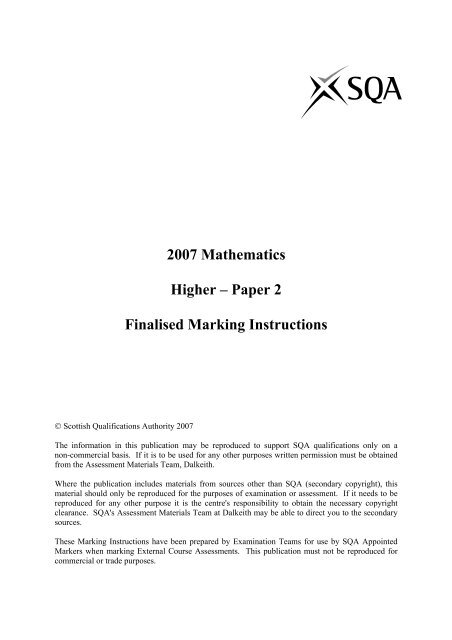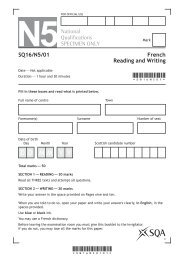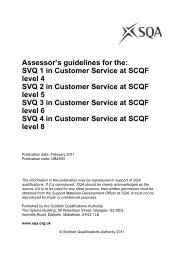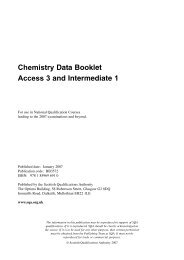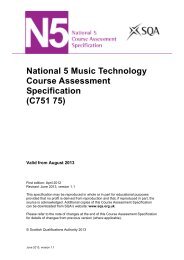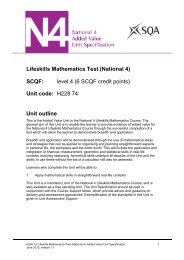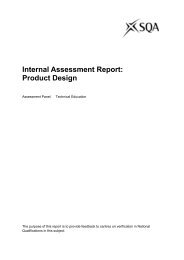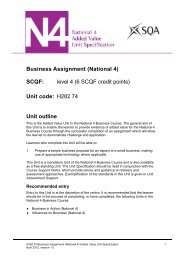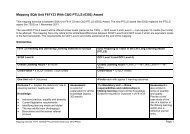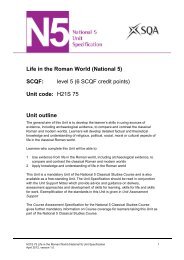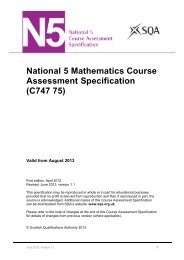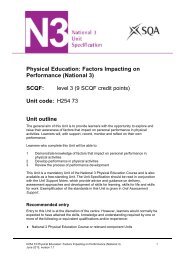2007 Mathematics Higher â Paper 2 Finalised Marking Instructions
2007 Mathematics Higher â Paper 2 Finalised Marking Instructions
2007 Mathematics Higher â Paper 2 Finalised Marking Instructions
You also want an ePaper? Increase the reach of your titles
YUMPU automatically turns print PDFs into web optimized ePapers that Google loves.
<strong>2007</strong> <strong>Mathematics</strong><br />
<strong>Higher</strong> – <strong>Paper</strong> 2<br />
<strong>Finalised</strong> <strong>Marking</strong> <strong>Instructions</strong><br />
© Scottish Qualifications Authority <strong>2007</strong><br />
The information in this publication may be reproduced to support SQA qualifications only on a<br />
non-commercial basis. If it is to be used for any other purposes written permission must be obtained<br />
from the Assessment Materials Team, Dalkeith.<br />
Where the publication includes materials from sources other than SQA (secondary copyright), this<br />
material should only be reproduced for the purposes of examination or assessment. If it needs to be<br />
reproduced for any other purpose it is the centre's responsibility to obtain the necessary copyright<br />
clearance. SQA's Assessment Materials Team at Dalkeith may be able to direct you to the secondary<br />
sources.<br />
These <strong>Marking</strong> <strong>Instructions</strong> have been prepared by Examination Teams for use by SQA Appointed<br />
Markers when marking External Course Assessments. This publication must not be reproduced for<br />
commercial or trade purposes.
<strong>Mathematics</strong> <strong>Higher</strong>: <strong>Instructions</strong> to Markers<br />
1. Marks must be assigned in accordance with these marking instructions. In principle, marks<br />
are awarded for what is correct, rather than marks deducted for what is wrong.<br />
2. Award one mark for each ‘bullet’ point. Each error should be underlined in RED at the<br />
point in the working where it first occurs, and not at any subsequent stage of the working.<br />
3. The working subsequent to an error must be followed through by the marker with possible<br />
full marks for the subsequent working, provided that the difficulty involved is<br />
approximately similar. Where, subsequent to an error, the working is eased, a deduction(s)<br />
of mark(s) should be made.<br />
This may happen where a question is divided into parts. In fact, failure to even answer an<br />
earlier section does not preclude a candidate from assuming the result of that section and<br />
obtaining full marks for a later section.<br />
4. Correct working should be ticked (√ ). This is essential for later stages of the SQA<br />
procedures. Where working subsequent to an error(s) is correct and scores marks, it should<br />
be marked with a crossed tick ( or X√ ). In appropriate cases attention may be<br />
directed to work which is not quite correct (e.g. bad form) but which has not been<br />
penalised, by underlining with a dotted or wavy line.<br />
Work which is correct but inadequate to score any marks should be corrected with a double<br />
cross tick ( ).<br />
5. • The total mark for each section of a question should be entered in red in the outer right<br />
hand margin, opposite the end of the working concerned.<br />
• Only the mark should be written, not a fraction of the possible marks.<br />
• These marks should correspond to those on the question paper and these instructions.<br />
6. It is of great importance that the utmost care should be exercised in adding up the marks.<br />
Where appropriate, all summations for totals and grand totals must be carefully checked.<br />
Where a candidate has scored zero marks for any question attempted, “0” should be shown<br />
against the answer.<br />
7. As indicated on the front of the question paper, full credit should only be given where the<br />
solution contains appropriate working. Accept answers arrived at by inspection or mentally<br />
where it is possible for the answer so to have been obtained. Situations where you may<br />
accept such working will normally be indicated in the marking instructions.<br />
8. Do not penalise:<br />
• working subsequent to a correct answer • omission of units<br />
• legitimate variations in numerical answers • bad form<br />
• correct working in the “wrong” part of a question<br />
2
<strong>Mathematics</strong> <strong>Higher</strong>: <strong>Instructions</strong> to Markers<br />
9. No piece of work should be scored through without careful checking - even where a<br />
fundamental misunderstanding is apparent early in the answer. Reference should always be<br />
made to the marking scheme - answers which are widely off-beam are unlikely to include<br />
anything of relevance but in the vast majority of cases candidates still have the opportunity<br />
of gaining the odd mark or two provided it satisfies the criteria for the mark(s).<br />
10. If in doubt between two marks, give an intermediate mark, but without fractions. When in<br />
doubt between consecutive numbers, give the higher mark.<br />
11. In cases of difficulty covered neither in detail nor in principle in the <strong>Instructions</strong>, attention<br />
may be directed to the assessment of particular answers by making a referal to the P.A.<br />
Please see the general instructions for P.A. referrals.<br />
12. No marks should be deducted at this stage for careless or badly arranged work. In cases<br />
where the writing or arrangement is very bad, a note may be made on the upper left-hand<br />
corner of the front cover of the script.<br />
13 Transcription errors: In general, as a consequence of a transcription error, candidates lose<br />
the opportunity of gaining either the first ic mark or the first pd mark.<br />
14 Casual errors: In general, as a consequence of a casual error, candidates lose the opportunity<br />
of gaining the appropriate ic mark or pd mark.<br />
15 Do not write any comments on the scripts. A revised summary of acceptable notation is<br />
given on page 4.<br />
16 Working that has been crossed out by the candidate cannot receive any credit. If you feel<br />
that a candidate has been disadvantaged by this action, make a P.A. Referral.<br />
17 Throughout this paper, unless specifically mentioned, a correct answer with no working<br />
receives no credit.<br />
Summary<br />
Throughout the examination procedures many scripts are remarked. It is essential that markers<br />
follow common procedures:<br />
1 Tick correct working.<br />
2 Put a mark in the outer right-hand margin to match the marks allocations on the question<br />
paper.<br />
3 Do not write marks as fractions.<br />
4 Put each mark at the end of the candidate’s response to the question.<br />
5 Follow through errors to see if candidates can score marks subsequent to the error.<br />
6 Do not write any comments on the scripts.<br />
3
<strong>Mathematics</strong> <strong>Higher</strong>: <strong>Instructions</strong> to Markers<br />
<strong>Higher</strong> <strong>Mathematics</strong> : A Guide to Standard Signs and Abbreviations<br />
Remember - No comments on the scripts. Please use the following and nothing else.<br />
Signs<br />
The tick. You are not expected to tick every line<br />
but of course you must check through the whole<br />
of a response.<br />
The cross and underline. Underline an error and<br />
place a cross at the end of the line.<br />
Bullets showing where marks are being<br />
allotted may be shown on scripts<br />
dy<br />
dx<br />
= 4x<br />
− 7<br />
4x<br />
− 7 = 0<br />
x =<br />
7<br />
4<br />
y = 3<br />
7<br />
8<br />
•<br />
•<br />
margins<br />
2<br />
The tick-cross. Use this to show correct work<br />
where you are following through subsequent to<br />
an error.<br />
C = ( 1, −1)<br />
3<br />
m = − ( − 1)<br />
4 −1<br />
m =<br />
m<br />
m<br />
rad<br />
tgt<br />
tgt<br />
4<br />
3<br />
= − 1<br />
4<br />
3<br />
= −<br />
3<br />
4<br />
3<br />
y − 3 = − x − 2<br />
4<br />
( )<br />
•<br />
•<br />
•<br />
3<br />
The roof. Use this to show something is missing<br />
such as a crucial step in a proof or a 'condition'<br />
etc.<br />
x<br />
2<br />
− 3x<br />
= 28<br />
x = 7<br />
•<br />
1<br />
The tilde. Use this to indicate a minor<br />
transgression which is not being penalised (such<br />
as bad form).<br />
sin( x) = 0. 75 = inv sin( 0. 75) = 48.<br />
6°<br />
•<br />
1<br />
The double cross-tick. Use this to show correct<br />
work but which is inadequate to score any<br />
marks. This may happen when working has been<br />
eased.<br />
Remember - No comments on the scripts. No abreviations. No new signs.<br />
Please use the above and nothing else.<br />
All of these are to help us be more consistent and accurate.<br />
Note: There is no such thing as a transcription error, a trivial error, a casual error or an<br />
insignificant error. These are all mistakes and as a consequence a mark is lost.<br />
Page 5 lists the syllabus coding for each topic. This information is given in the legend underneath<br />
the question. The calculator classification is CN(calculator neutral), CR(calculator<br />
required) and NC(non-calculator).<br />
4
Year<br />
A1 determine range/domain A15 use the general equation of a parabola A28 use the laws of logs to simplify/find equiv. expression<br />
A2 recognise general features of graphs:poly,exp,log A16 solve a quadratic inequality A29 sketch associated graphs<br />
A3 sketch and annotate related functions A17 find nature of roots of a quadratic A30 solve equs of the form A = Be kt for A,B,k or t<br />
A4 obtain a formula for composite function A18 given nature of roots, find a condition on coeffs A31 solve equs of the form log b (a) = c for a,b or c<br />
A5 complete the square A19 form an equation with given roots A32 solve equations involving logarithms<br />
A6 interpret equations and expressions A20 apply A15-A19 to solve problems A33 use relationships of the form y = ax n or y = ab x<br />
1 2 UNIT 1 1 2 UNIT 2 1 2 UNIT 3<br />
A7 determine function(poly,exp,log) from graph & vv A34 apply A28-A33 to problems<br />
A8 sketch/annotate graph given critical features<br />
A9 interpret loci such as st.lines,para,poly,circle<br />
A10 use the notation u n for the nth term A21 use Rem Th. For values, factors, roots G16 calculate the length of a vector<br />
A11 evaluate successive terms of a RR A22 solve cubic and quartic equations G17 calculate the 3rd given two from A,B and vector AB<br />
A12 decide when RR has limit/interpret limit A23 find intersection of line and polynomial G18 use unit vectors<br />
A13 evaluate limit A24 find if line is tangent to polynomial G19 use: if u, v are parallel then v = ku<br />
A14 apply A10-A14 to problems A25 find intersection of two polynomials G20 add, subtract, find scalar mult. of vectors<br />
A26 confiirm and improve on approx roots G21 simplify vector pathways<br />
A27 apply A21-A26 to problems G22 interpret 2D sketches of 3D situations<br />
G23 find if 3 points in space are collinear<br />
G24 find ratio which one point divides two others<br />
G1 use the distance formula G9 find C/R of a circle from its equation/other data G25 given a ratio, find/interpret 3rd point/vector<br />
G2 find gradient from 2 pts,/angle/equ. of line G10 find the equation of a circle G26 calculate the scalar product<br />
G3 find equation of a line G11 find equation of a tangent to a circle G27 use: if u, v are perpendicular then v.u=0<br />
G4 interpret all equations of a line G12 find intersection of line & circle G28 calculate the angle between two vectors<br />
G5 use property of perpendicular lines G13 find if/when line is tangent to circle G29 use the distributive law<br />
G6 calculate mid-point G14 find if two circles touch G30 apply G16-G29 to problems eg geometry probs.<br />
G7 find equation of median, altitude,perp. bisector G15 apply G9-G14 to problems<br />
G8 apply G1-G7 to problems eg intersect.,concur.,collin.<br />
C1 differentiate sums, differences C12 find integrals of px n and sums/diffs C20 differentiate psin(ax+b), pcos(ax+b)<br />
C2 differentiate negative & fractional powers C13 integrate with negative & fractional powers C21 differentiate using the chain rule<br />
C3 express in differentiable form and differentiate C14 express in integrable form and integrate C22 integrate (ax + b) n<br />
C4 find gradient at point on curve & vv C15 evaluate definite integrals C23 integrate psin(ax+b), pcos(ax+b)<br />
C5 find equation of tangent to a polynomial/trig curve C16 find area between curve and x-axis C24 apply C20-C23 to problems<br />
C6 find rate of change C17 find area between two curves<br />
C7 find when curve strictly increasing etc C18 solve differential equations(variables separable)<br />
C8 find stationary points/values C19 apply C12-C18 to problems<br />
C9 determinenature of stationary points<br />
C10 sketch curvegiven the equation<br />
C11 apply C1-C10 to problems eg optimise, greatest/least<br />
T1 use gen. features of graphs of f(x)=ksin(ax+b), T7 solve linear & quadratic equations in radians T12 solve sim.equs of form kcos(a)=p, ksin(a)=q<br />
f(x)=kcos(ax+b); identify period/amplitude T8 apply compound and double angle (c & da) formulae T13 express pcos(x)+qsin(x) in form kcos(x±a)etc<br />
T2 use radians inc conversion from degrees & vv in numerical & literal cases T14 find max/min/zeros of pcos(x)+qsin(x)<br />
T3 know and use exact values T9 apply c & da formulae in geometrical cases T15 sketch graph of y=pcos(x)+qsin(x)<br />
T4 recognise form of trig. function from graph T10 use c & da formulaewhen solving equations T16 solve equ of the form y=pcos(rx)+qsin(rx)<br />
T5 interpret trig. equations and expressions T11 apply T7-T10 to problems T17 apply T12-T16 to problems<br />
T6 apply T1-T5 to problems<br />
page 5
<strong>2007</strong> Question <strong>Paper</strong> 2 <strong>Marking</strong> Scheme v5<br />
2.01<br />
qu part mk code calc source ss pd ic C B A<br />
2.01 a 1 G21, G28 CN 7044 1 1<br />
b 2 CN 2 2<br />
c 5 CN 1 4 5<br />
OABCDEFG is a cube with side 2 units, as shown in the diagram.<br />
B has coordinates (2, 2, 0).<br />
P is the centre of face OCGD and Q is the centre of face CBFG.<br />
(a) Write down the coordinates of G. 1<br />
(b) Find p and q, the position vectors of points P and Q. 2<br />
(c) Find the size of angle POQ. 5<br />
z<br />
D<br />
G<br />
P<br />
C<br />
Q<br />
E<br />
F<br />
y<br />
B (2, 2, 0)<br />
O<br />
A<br />
x<br />
The primary method m.s is based on the following generic m.s.<br />
This generic marking scheme may be used as an equivalence guide<br />
but only where a candidate does not use the primary method or any<br />
alternative method shown in detail in the marking scheme.<br />
• 1 ic interpret 2-D sketch of 3-D situation<br />
• 2 ic interpret coordinates to vector<br />
• 3 ic interpret coordinates to vector<br />
• 4 ss knows to use scalar product<br />
• 5 pd process length<br />
• 6 pd process length<br />
• 7 pd process process scalar product<br />
• 8 pd process angle<br />
Notes 1<br />
1 Treat coordinates written as column vectors as bad form<br />
2 In (b), if p is wrong, this may be a follow through from<br />
(a) which has wrong coordinates for G.<br />
3 For candidates who do not attempt • 8 , the formula<br />
quoted at • 4 must relate to the labelling in the<br />
question for • 4 to be awarded.<br />
4 In (c) for • 8 accept answers which round to 30°(2 s.f.)<br />
5 In (c) • 4 is not available for candidates who choose to<br />
calculate an incorrect angle (e.g. angle OPQ).<br />
Primary Method : Give 1 mark for each •<br />
• 1 G = (0,2,2)<br />
• 2 ! 0$<br />
p =<br />
1<br />
"#<br />
1%<br />
&<br />
• 3 ! 1$<br />
q =<br />
2<br />
"#<br />
1%<br />
&<br />
• 4<br />
p.q<br />
cosPÔQ =<br />
p q<br />
• 5 p = 2<br />
• 6 q = 6<br />
• 7 p.q = 3<br />
8<br />
• PÔQ = 30°<br />
[radians : ! 6<br />
Alternative Method for • 4 to • 8<br />
• 4 cosPÔQ = OP2 +OQ 2 -PQ 2<br />
• 5 OP = 2<br />
• 6 OQ = 6<br />
• 7 PQ = 2<br />
8<br />
• PÔQ = 30°<br />
stated or implied (s/i) by • 8<br />
(0.524); gradians : 33.3 ]<br />
2!OP!OQ<br />
[radians : ! (0.524); gradians : 33.3 ]<br />
6<br />
p and q must be stated<br />
explicitly as a column<br />
(or row) vector<br />
stated or implied (s/i) by • 8<br />
6
<strong>2007</strong> Question <strong>Paper</strong> 2 <strong>Marking</strong> Scheme v5<br />
2.02<br />
qu part mk code calc source ss pd ic C B A<br />
2.02 a 4 T9 CN 7098 1 1 2 4<br />
b 4 2 1 1 4<br />
The diagram shows two right-angled triangles with<br />
angles c and d marked as shown.<br />
(a) Find the exact value of sin(c + d). 4<br />
(b) (i) Find the exact value of sin 2c<br />
(ii) Show thatcos2d has the same exact value. 4<br />
c<br />
1<br />
2 3<br />
d<br />
The primary method m.s is based on the following generic m.s.<br />
This generic marking scheme may be used as an equivalence guide<br />
but only where a candidate does not use the primary method or any<br />
alternative method shown in detail in the marking scheme.<br />
• 1 ic interpret the diagram<br />
• 2 ss expand<br />
• 3 ic substitute<br />
• 4 pd simplify<br />
• 5 ss use double angle formula<br />
• 6 pd process<br />
• 7 ss use double angle formula<br />
• 8 ic complete proof of equality<br />
Notes 1<br />
1 Any attempt to use sin(c + d) = sinc + sind<br />
loses • 2 , • 3 and • 4<br />
( ) cos 3<br />
( ) + cos ( 2 5) sin ( 1 10<br />
) as<br />
2 At • 3 treat sin 1 5 10<br />
bad form if the trig functions disappear to give<br />
the answer<br />
3 At the • 3 stage do not penalise the use of fractions<br />
which are greater than 1<br />
4 Neither • 4 nor • 6 are available for answers >1<br />
5 Any work based on sin 2c = 2sinc loses • 5 and • 6<br />
6 Any work based on cos2d = 2cosd loses • 7 and • 8<br />
7 In (b) candidates may calculate sin 2c and cos2d<br />
in any order. If either sin 2c or cos2d is correct<br />
that may be awarded 2 of the 4 marks available<br />
8 Any working based on numerical values for c and d<br />
(eg 27° and 18°) earns no credit but • 1 , • 2 , • 5 and<br />
• 7 are still available.<br />
9 • 8 is only available if the answer to (b)(ii) is shown<br />
to be equivalent to the answer to (b)(i)<br />
10 If 5 and 10 are approximated to decimal values<br />
then • 4 ,• 6 and • 8 are not available.<br />
Primary Method : Give 1 mark for each •<br />
• 1 5 and 10 s/i by • 3<br />
• 2 sin(c)cos(d) + cos(c)sin(d) s/i by • 3<br />
• 3 1<br />
!<br />
5 3 + 2 !<br />
10 5 1 10<br />
• 4 1<br />
2<br />
(accept any equivalent single fraction)<br />
• 5<br />
2sin(c)cos(c)<br />
• 6 2! 1 ! 2 = 4<br />
5 5 5<br />
• 7<br />
e.g. cos 2 (d)" sin 2 (d)<br />
• 8 9<br />
10 " 1<br />
10 = 8<br />
10 = 4 5<br />
Common Errors<br />
1 sin 2c = 2sind cosd<br />
sin 2c = 2 1 10<br />
3<br />
10<br />
2 cos2d = cos 2 c ! sin 2 c<br />
cos2d = 2 5<br />
2<br />
5 ! 1 5<br />
or equivalent<br />
award 1 mark from • 5 and • 6<br />
15 award 1 mark from •7 and • 8<br />
7
<strong>2007</strong> Question <strong>Paper</strong> 2 <strong>Marking</strong> Scheme v5<br />
2.03<br />
qu part mk code calc source ss pd ic C B A<br />
2.03 6 G13 CN 1 1 4 6<br />
Show that the line with equation y = 6 ! 2x is a tangent to the circle<br />
with equation x 2 + y 2 + 6x ! 4y ! 7 = 0 and find the coordinates of<br />
the point of contact of the tangent and the circle. 6<br />
The primary method m.s is based on the following generic m.s.<br />
This generic marking scheme may be used as an equivalence guide<br />
but only where a candidate does not use the primary method or any<br />
alternative method shown in detail in the marking scheme.<br />
• 1 ss substitute<br />
• 2 pd expand brackets<br />
• 3 ic express in standard form<br />
• 4 ic factorise<br />
• 5 ic complete proof<br />
• 6 ic state coordinates<br />
Primary Method : Give 1 mark for each •<br />
• 1 x 2 + (6 ! 2x) 2 + 6x ! 4(6 ! 2x)! 7 = 0<br />
• 2<br />
.....36 ! 24x + 4x 2 ....! 24 + 8x....<br />
• 3 5x 2 !10x + 5 = 0<br />
• 4 (x !1) 2 = 0<br />
• 5<br />
equal roots " line is tangent<br />
• 6 x = 1, y = 4<br />
alternatives for • 4 and • 5<br />
• 4<br />
b 2 ! 4ac = 0 " tangent<br />
• 5 (!10) 2 ! 4 #5#5 = 0<br />
• 4<br />
• 5<br />
use quad. formula to get roots<br />
equal roots " line is tangent<br />
Notes 1<br />
1 An " = 0 " must appear somewhere in the working<br />
between • 1 and • 4 stage. Failure to appear will<br />
lose one of these marks<br />
2 For candidates who obtain 2 roots:<br />
• 5 is still available for "not equal roots so NO<br />
tangent" but • 6 is not available<br />
Alternative Method : Give 1 mark for each •<br />
• 1 m line<br />
= !2<br />
• 2 (!3,2) and 1 2<br />
• 3 equ. of radius : y ! 2 = 1 (x + 3)<br />
2<br />
• 4 x = 1<br />
• 5 y = 4<br />
• 6<br />
check that (1,4) lies on the circle<br />
8
<strong>2007</strong> Question <strong>Paper</strong> 2 <strong>Marking</strong> Scheme v5<br />
2.04<br />
qu part mk code calc source ss ic C B A<br />
2.04 a 3 T4, T7 CN 7102 3 3<br />
b 3 CN 1 2 3<br />
The diagram shows part of the graph of a function<br />
whose equation is of the form y = a sin(bx°) + c.<br />
(a) Write down the values of a, b and c. 3<br />
(b) Determine the exact value of the x -coordinate of P, the<br />
point where the graph intersects the x -axis as shown in<br />
the diagram. 3<br />
y<br />
1<br />
O<br />
–1<br />
–2<br />
P<br />
60° 120°<br />
x<br />
–3<br />
The primary method m.s is based on the following generic m.s.<br />
This generic marking scheme may be used as an equivalence guide<br />
but only where a candidate does not use the primary method or any<br />
alternative method shown in detail in the marking scheme.<br />
• 1 ic interpret vertical scaling<br />
• 2 ic interpret period<br />
• 3 ic interpret vertical translation<br />
• 4 ss set to zero<br />
• 5 pd process exact value<br />
• 6 ic interpret diagram<br />
Primary Method : Give 1 mark for each •<br />
• 1 a = 2<br />
• 2 b = 3<br />
• 3 c = !1<br />
• 4 2sin(3x°)!1 = 0<br />
• 5 one answer from 10° or 50°<br />
• 6 x P<br />
= 50°<br />
alternative for • 4 ,• 5 and • 6<br />
solution via a graphics calculator<br />
• 4 ss sketch and annotate<br />
• 5 ic interpret scale<br />
• 6 ic check exact value<br />
• 4<br />
sketch!of!graph!with!pointer!to!sol.point<br />
• 5 extraction of 50°<br />
• 6 confirmation of 2sin( 3"50° ) !1 does = 0<br />
Notes 1<br />
1 • 4 may be awarded for a sin(bx) + c = 0<br />
2 For • 2 accept " b = 3x " as bad form<br />
3 • 6 may only be awarded for a value of x such<br />
that 30 < x < 60<br />
4 • 6 may be awarded for (50°,0) but NOT for (0,50°)<br />
9
<strong>2007</strong> Question <strong>Paper</strong> 2 <strong>Marking</strong> Scheme v5<br />
qu part mk code calc source ss pd ic C B A<br />
2.05<br />
2.05 a 5 C5,G10,G11 CN 7017 2 2 1 5<br />
b 2 1 1 2<br />
c 2 2 2<br />
A circle centre C is situated so that it touches the<br />
y<br />
parabola with equation y = 1 2 x 2 ! 8x + 34 at P and Q.<br />
(a) The gradient of the tangent to the parabola<br />
at Q is 4. Find the coordinates of Q. 5<br />
(b) Find the coordinates of P. 2<br />
(c) Find the coordinates of C, the centre of the circle. 2<br />
P<br />
C<br />
Q<br />
O<br />
x<br />
The primary method m.s is based on the following generic m.s.<br />
This generic marking scheme may be used as an equivalence guide<br />
but only where a candidate does not use the primary method or any<br />
alternative method shown in detail in the marking scheme.<br />
• 1 ss know to differentiate<br />
• 2 pd process<br />
• 3 ss equate gradients<br />
• 4 pd process<br />
• 5 ic interpret y-coordinate<br />
• 6 ss use symmetry of diagram<br />
• 7 ic interpret coordinates<br />
• 8 ic interpret centre<br />
• 9 ic interpret centre<br />
Notes 1<br />
1 Treat y = x ! 8 as bad form provided y is<br />
replaced by 4 at • 3<br />
2 Cave<br />
Look out for the following:<br />
• 5 is not available to candidates who substitute<br />
the gradient of 4 into the equation in order to<br />
Primary Method : Give 1 mark for each •<br />
• 1 dy<br />
= ...(1 term correct)<br />
dx<br />
• 2 x ! 8<br />
• 3 x ! 8 = 4<br />
• 4 x = 12<br />
• 5 y = 10<br />
• 6 m P<br />
= !4<br />
• 7 P = (4,10)<br />
• 8 x C<br />
= 8<br />
• 9 y C<br />
= 11<br />
Alternative Method for (c)<br />
Solving the normals<br />
i.e. y !10 = ! 1 (x !12)<br />
4<br />
y !10 = 1 (x ! 4)<br />
4<br />
may be used. Marks are awarded as normal:<br />
x = 8 (• 8 ) and y = 11 (• 9 )<br />
find the value of y Q<br />
3 Alt. strategies for • 6<br />
(a) substitute y = 10 into the parabola<br />
(b) use the t.p. as a step to P<br />
4 Cave<br />
There are other legitimate methods for<br />
finding the coordinates of Q<br />
5 Candidates who solve the tangents at P and Q<br />
AND then state that x C<br />
= 8 may be awarded • 8 .<br />
Common Errors<br />
1<br />
dy<br />
= x ! 8 " dx •1 , " • 2<br />
x ! 8 = 0 # x = 8,y = 2 " • 5<br />
2 For the occasional candidate who starts<br />
with x ! 8 = 4<br />
award • 1 ,• 2 and • 3<br />
10
<strong>2007</strong> Question <strong>Paper</strong> 2 <strong>Marking</strong> Scheme v5<br />
2.06<br />
qu part mk code calc source ss ic C B A<br />
2.06 a 3 C11 CN 7062 1 2 3<br />
b 5 CN 1 3 1 1 4<br />
A householder has a garden in the shape of a right-angled<br />
isosceles triangle.<br />
It is intended to put down a section of rectangular wooden<br />
decking at the side of the house, as shown in the diagram.<br />
10m<br />
Decking<br />
10m<br />
x m<br />
S<br />
Side Wall<br />
T<br />
(a) (i) Find the exact value of ST.<br />
(ii) Given that the breadth of the decking is x metres, show that<br />
the area of the decking, A square metres, is given by<br />
( ) x ! 2x<br />
2<br />
A = 10 2<br />
(b) Find the dimensions of the decking which maximises its area. 5<br />
3<br />
The primary method m.s is based on the following generic m.s.<br />
This generic marking scheme may be used as an equivalence guide<br />
but only where a candidate does not use the primary method or any<br />
alternative method shown in detail in the marking scheme.<br />
• 1 pd calculate ST<br />
• 2 ic interpret the triangle<br />
• 3 ic complete proof<br />
• 4 ss set derivative zero<br />
• 5 pd differentiate<br />
• 6 pd solve for breadth<br />
• 7 ic justify s.p.s with e.g. nature table<br />
• 8 pd find corresponding length<br />
Notes 1<br />
In (b)<br />
1 An " = 0 " must appear somewhere in the working<br />
between • 4 and • 6<br />
2 For • 7 accept d 2 A<br />
= !4 < 0 at x = 10 2 " maximum<br />
dx 2 4<br />
Primary Method : Give 1 mark for each •<br />
• 1 ST = 200<br />
• 2 length = 200 ! 2x s/i by their method<br />
• 3<br />
( 200 ! 2x )"x<br />
• 4<br />
• 5<br />
and complete proof<br />
dA<br />
dx = 0<br />
dA<br />
= 10 2 ! 4x<br />
dx<br />
• 6 x = 10 2 or equivalent (3.5)<br />
4<br />
• 7 justification : e.g. nature table<br />
• 8 length = 5 2 (7.1)<br />
Minimum requirement of a nature table<br />
... 3.5 ...<br />
f !(x) + 0 "<br />
hence maximum<br />
better would be<br />
x # 5 2 #<br />
2<br />
f !(x) + 0 "<br />
f(x) ! " #<br />
hence maximum<br />
at x = 5 2<br />
2<br />
11
<strong>2007</strong> Question <strong>Paper</strong> 2 <strong>Marking</strong> Scheme v5<br />
2.07<br />
qu part mk code calc source ss pd ic C B A<br />
2.07 4 C23, T3 CR 7046 3 1 3 1<br />
2<br />
Find the value of ! sin( 4x + 1) dx . 4<br />
0<br />
The primary method m.s is based on the following generic m.s.<br />
This generic marking scheme may be used as an equivalence guide<br />
but only where a candidate does not use the primary method or any<br />
alternative method shown in detail in the marking scheme.<br />
Primary Method : Give 1 mark for each •<br />
• 1 !cos(4x + 1)<br />
• 2 " 1 4<br />
• 1 pd integrate the trig function<br />
• 2 pd deal with the "4"<br />
• 3 ic substitute the limits<br />
• 4 pd evaluate<br />
Notes 1<br />
1 • 2 is only available if it follows on from<br />
±sin(4x + 1) or ±cos(4x + 1)<br />
2 • 3 is available for substituting the limits correctly<br />
into any trig. function except the original one<br />
3 • 4 is available for using any trig. function except<br />
the original one<br />
4 If candidates leave the calculator in degree mode<br />
obtaining 0.000304 then • 4 is NOT awarded<br />
• 3 ! 1 4 cos(4 "2 + 1)! #<br />
! 1 &<br />
cos(4 "0 + 1)<br />
$ % 4 '(<br />
• 4 0.36<br />
Alternative Method<br />
• 1<br />
sin 4x cos1 + cos 4x sin1<br />
! 1 cos 4x cos1<br />
4<br />
• 2 1<br />
sin 4x sin1<br />
4<br />
• 3<br />
(! 1 cos8cos1 + 1 sin 8sin1<br />
4 4<br />
)!(! 1 cos0cos1 + 1 sin 0sin1<br />
4 4<br />
)<br />
• 4 0.36<br />
12
<strong>2007</strong> Question <strong>Paper</strong> 2 <strong>Marking</strong> Scheme v5<br />
2.08<br />
qu part mk code calc source ss pd ic C B A<br />
2.08 4 A31 CR 7049 2 1 1 4<br />
The curve with equation y = log 3<br />
(x !1)! 2.2, where x > 1,<br />
cuts the x -axis at the point (a, 0).<br />
Find the value of a. 4<br />
The primary method m.s is based on the following generic m.s.<br />
This generic marking scheme may be used as an equivalence guide<br />
but only where a candidate does not use the primary method or any<br />
alternative method shown in detail in the marking scheme.<br />
• 1 ic substitute<br />
• 2 ss isolate the log term<br />
• 3 ss convert to exponential form<br />
• 4 pd process<br />
Primary Method : Give 1 mark for each •<br />
• 1 log 3<br />
(a !1)! 2.2 = 0 s/i by • 2<br />
• 2 log 3<br />
(a !1) = 2.2<br />
• 3 a !1 = 3 2.2<br />
• 4 a = 12.2<br />
Alt.method 1<br />
• 1 log 3<br />
(a !1)! 2.2 = 0 s/i by • 2<br />
• 2 log 3<br />
(a !1) = 2.2<br />
• 3 log 3<br />
(a !1) = log 3<br />
(11.21)<br />
• 4 a = 12.2<br />
Alt.method 2<br />
• 1 log 3<br />
(a !1)! 2.2 = 0 s/i by • 2<br />
log 3<br />
(a !1)! 2.2log 3<br />
3 = 0<br />
• 2 log 3<br />
(a !1)! log 3<br />
(11.21) = 0<br />
• 3<br />
log 3<br />
(a!1)<br />
11.21 = 0<br />
• 4 a = 12.2<br />
Notes 1<br />
1 Solutions given in terms of x rather than a should<br />
be treated as bad form.<br />
Common Error 1<br />
• 1 ! log 3<br />
(a "1)" 2.2 = 0<br />
• 2 ! log 3<br />
(a "1) = 2.2<br />
• 3 X log 3<br />
(a "1) = log 3<br />
2.2<br />
• 4 X a "1 = 2.2 # a = 3.2 [eased]<br />
Common Error 2<br />
• 1 ! log 3<br />
(a "1)" 2.2 = 0<br />
• 2 ! log 3<br />
(a "1) = 2.2<br />
• 3 X log 3<br />
a " log 3<br />
1 = 2.2<br />
log 3<br />
a = 2.2<br />
• 4 X ! a = 3 2.2 = 11.2<br />
13
<strong>2007</strong> Question <strong>Paper</strong> 2 <strong>Marking</strong> Scheme v5<br />
2.09<br />
qu part mk code calc source ss ic C B A U1 U2 U3<br />
2.09 a 2 A3 CN 7071 2 2 2<br />
b 2 CN 2 2 2<br />
The diagram shows the graph of y = a x , a > 1.<br />
On separate diagrams sketch the graphs of:<br />
y<br />
y = a x<br />
(a) y = a !x 2<br />
(b) y = a 1!x 2<br />
1<br />
(1, a)<br />
O<br />
x<br />
The primary method m.s is based on the following generic m.s.<br />
This generic marking scheme may be used as an equivalence guide<br />
but only where a candidate does not use the primary method or any<br />
alternative method shown in detail in the marking scheme.<br />
• 1 ic determine the requ. transformation<br />
• 2 ic state coordinates of pt. on graph<br />
• 3 ic determine the requ. transformation<br />
• 4 ic state coordinates of pt. on graph<br />
Primary Method : Give 1 mark for each •<br />
• 1 reflecting in y-axis and passing thr' e.g. (0,1)<br />
• 2<br />
"<br />
passing thr' 1 more point e.g. (!1,a) or 1, 1 %<br />
# $ a &'<br />
• 3<br />
vertical scaling of "a " and passing thr' e.g. (0,a)<br />
• 4 passing thr' 1 more point e.g. (!1,a 2 ) or (1,1)<br />
y<br />
y = a –x<br />
(–1, a)<br />
1<br />
O<br />
x<br />
y<br />
y = a 1–x<br />
(–1, a 2 )<br />
1<br />
a<br />
(1, 1)<br />
O<br />
x<br />
Notes 1<br />
1 For • 1 and • 3 the shape must be an exponential<br />
decay graph lying above the x -axis<br />
2 There are no follow-through marks available to<br />
candidates who use an incorrect graph from (a) as a<br />
basis for their answer to (b).<br />
14
<strong>2007</strong> Question <strong>Paper</strong> 2 <strong>Marking</strong> Scheme v5<br />
2.10<br />
qu part mk code calc source ss ic C B A<br />
2.10 a 3 C18, C19 CN 7028 1 1 1 1 2<br />
b 4 CN 1 1 2 4<br />
The diagram shows the graphs of a cubic function y = f(x) and its<br />
derived function y = f !(x).<br />
y<br />
y = f(x)<br />
Both graphs pass through the point (0,6).<br />
The graph of y = ! f (x) also passes through the points (2,0) and (4,0).<br />
6<br />
(a) Given that ! f (x) is of the form k(x "a)(x "b)<br />
(i) Write down the values of a and b.<br />
(ii) Find the value of k. 3<br />
(b) Find the equation of the graph of the cubic function y = f(x). 4<br />
O<br />
2 4<br />
y = f '(x)<br />
x<br />
The primary method m.s is based on the following generic m.s.<br />
This generic marking scheme may be used as an equivalence guide<br />
but only where a candidate does not use the primary method or any<br />
alternative method shown in detail in the marking scheme.<br />
• 1 ic interpret roots on diagram<br />
• 2 ss know to use y-intercept<br />
• 3 pd process<br />
• 4 ss know to integrate<br />
• 5 pd integrate<br />
• 6 ic express as an equation<br />
• 7 ic interpret constant of integration<br />
Primary Method : Give 1 mark for each •<br />
• 1 a = 2 and b = 4 or k(x ! 2)(x ! 4)<br />
• 2 6 = k(0 ! 2)(0 ! 4)<br />
• 3 k = 3 4<br />
• 4 3<br />
" ( (x ! 2)(x ! 4)<br />
4<br />
) dx s/i by • 5<br />
• 5 any two terms integrated correctly ( 3 etc)<br />
12<br />
• 6 y = 1 x 3 ! 9 x 2 + 6x + c<br />
4 4<br />
• 7 c = 6<br />
Notes 1<br />
1 For candidates who fail to complete (a) but produce<br />
values for k,a and b ex nihilo, all 4 marks are<br />
available in (b).<br />
A deduction of 1 mark may be made if their choice<br />
eases the working.<br />
2 In (b)<br />
For candidates who use k = 1, a "fully correct"<br />
follow-through solution may be awarded 3 out<br />
of the last 4 marks<br />
3 For candidates who retain "k", "a" and "b ",<br />
• 4 ,• 5 ,• 6 and • 7 are still available.<br />
15
<strong>2007</strong> Question <strong>Paper</strong> 2 <strong>Marking</strong> Scheme v5<br />
2.11<br />
qu part mk code calc source ss pd ic C B A U1 U2 U3<br />
2.11 a 1 A33 CR 7014 1 1 1<br />
b 1 1 1 1<br />
c 4 1 3 4 4<br />
Two variables x and y satisfy the equation y = 3! 4 x .<br />
(a) Find the value of a if (a,6) lies on the graph with<br />
equation y = 3! 4 x . 1<br />
(b) If (" 1 ,b) also lies on the graph, find b. 1<br />
2<br />
(c) A graph is drawn of log 10<br />
y against x. Show that its equation<br />
will be of the form log 10<br />
y = Px +Q and state the gradient of<br />
this line. 4<br />
The primary method m.s is based on the following generic m.s.<br />
This generic marking scheme may be used as an equivalence guide<br />
Primary Method : Give 1 mark for each •<br />
but only where a candidate does not use the primary method or any<br />
alternative method shown in detail in the marking scheme.<br />
• 1 a = 1 2<br />
• 1 ic interprets equation<br />
• 2 ic interprets equation<br />
• 3 ss introduces logs<br />
• 4 ic uses log law<br />
• 5 ic uses log law and completes<br />
• 6 ic interprets equation<br />
Notes<br />
1 Do not penalise x = 1 2 , y = 3 2<br />
2 Candidates who start their "proof" with the<br />
wrong form (e.g. y = Px Q ) earn no credit<br />
in part (c).<br />
• 2 b = 3 2<br />
• 3 log 10<br />
(y) = log 10<br />
3! 4 x<br />
( )<br />
( )<br />
• 4 log 10<br />
(y) = log 10<br />
(3) + log 10<br />
4 x<br />
• 5 log 10<br />
(y) = x log 10<br />
(4) + log 10<br />
(3)<br />
• 6<br />
gradient = log 10<br />
(4) or equivalent<br />
Alternative Method<br />
• 1 Px +Q<br />
y = 10<br />
• 2<br />
y = 10 Q !(10 P ) x<br />
• 3 10 Q = 3 and 10 P = 4<br />
• 4 P = log 10<br />
4<br />
Cave<br />
In (a) look out for the following :<br />
6 = 3! 4 a<br />
2 = 4 a<br />
2<br />
4 = a<br />
a = 1 2<br />
This is not awarded • 1<br />
16


